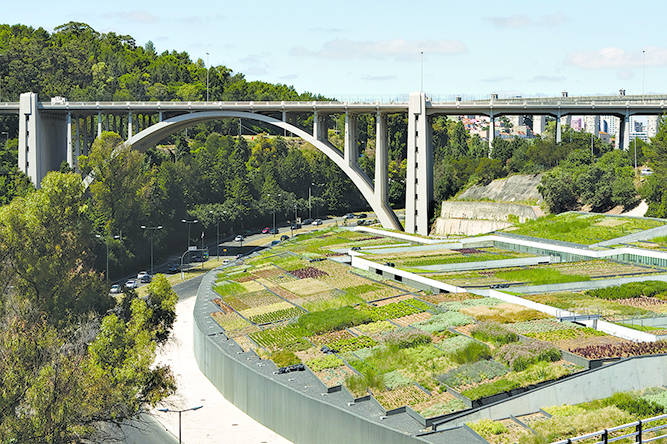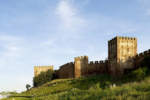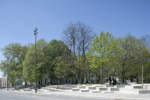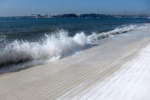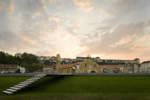ETAR de Alcântara, Lisbon, Portugal (2005-2011). Photo by Diogo Bento
A lot has already been written on landscape design, and one often runs the risk of suggesting and accepting simplistic approximations generated by the incredible force of the contingent cultural context, approximations that are set in a context that leads us to make assertions as frequent as those claiming that the landscape and its planning is related to the preservation of nature, or the creation of beauty or the choice of plants, or other partial approaches that are extremely dangerous if they become the dominant concept of a project.
A more careful observation reveals an extraordinary diversity in the presentation of interpretation of the concept of landscape: there are several definitions of landscape, which limit the concept solely to a dimension of image, ignoring that at any point in the dynamic process to which the Landscape in fact corresponds, the image is only the evident manifestation of a function.
The importance of finding a definition of landscape capable of guiding planning activities becomes absolute, and the proposal presented here represents an attempt to meet this demand: a definition of the concept of landscape that allows an efficacious and efficient delineation of projects, and that thus makes it possible to consider the processual and dynamic character of the Landscape, the idea that every moment of its construction is transitory, the awareness that the signals proposed by the new transformation which this idea should conceptually sustain will always, whether we like it or not, be traced by building relations with the signals that have previously been impressed in the course of the history of that landscape and, together with them, build relations with the signs associated with future transformations. The concept of landscape corresponds to a dynamic constructive process which begins with the very same geological genesis of the physical territory, which continues to be constructed in the consecutive expression of all transformations of a deteriorative, entropic character, through erosive or meteoric processes and through processes of transformation associated with the consolidation of the vegetation, the exercise of the life of the fauna and, in particular, of the human communities. We are therefore speaking of a continuous superimposition of signals that register all the spontaneous transformative processes, all of the involuntary and accidental movements, all of the intentional gestures of transformation through the relative specific traces. This means that, since the origin of the Earth, each place registers a continuous superimposition of signs corresponding to the inclusion of functions where every process is identifiable as part of the history of a place; while this happens, in some places, according to a succession that may be chronologically determined by an order of superimposition (signs linked to geological conditions and foundations, signs related to entropic conditions, deterioration and the construction of the ground, associated with meteoric, erosive or pedogenetic processes; biotic signs produced by indications associated with life, and anthropic signs corresponding to the accumulation of traces formed by human communities), in others this order of succession may be suddenly inverted or altered by the sudden appearance of a geological process, or simply correspond to the parallel development of various processes of this kind.
Within the context of the dominion of the anthropic genesis, a restriction with respect to the processes of transformation of the landscape, every community and every generation leaves traces on the territory corresponding to the transformative processes corresponding to its convictions, and every community and generation seeks to transform the territory in order to optimize its conditions of survival, comfort and safety, and to assure the maintenance of these optimized conditions for later generations.
Each generation reads, in the territory and in the relations between that territory and the context – that is to say the economic, technological, cultural and political context – a set of problems on whose solution, concretized through real actions of transformation of the territory, the actual improvement of living conditions of the relative communities may depend.
The signals which characterize the correspondent transformations will testify the passage of that generation and that community on Earth, like a signature capable of translating its values, its convictions and its ability to concretize them, its talent in giving them a material form. It will be up to the future to prove the actual efficiency of those proposals, or the affective value which the signals representing them have succeeded in building with the communities and which may have produced a symbolic dimension sufficient for its inscription in the collective imagery of populations.
The construction of the landscape is made of these moments and these signs, and it is important to underscore that, in every instant of the process of their construction, the signs that are impressed are traced in the name of an understanding of their relationship with the other signs that are contemporary with them and with all the signs that have preceded them, thus giving rise to a complex tissue that is transversal in time (as it concerns contemporary relations) and vertical in time (as it features relations between different periods).
The landscape is the product of this continuous superimposition in the course of very long timespans, and it is therefore logical to conclude that, if a landscape has to do with space, it will undoubtedly also have to do with time.
And if this is the case, then working with the landscape, planning its conscious transformation, whether this takes place through the design of the space of a park, a garden, a public area – either through planning indications and readings of relations with the surroundings in the design of buildings or aggregates of buildings, or also through actions of a character associated with the planning of future transformations – means to estimate the consequences over time of the planned constructive actions, of the suggested transformations, and to manage to develop this awareness not only through a knowledge of the behaviour of each initiative and their aggregate over time, but also of the way in which these actions relate to the sum of transformations which have, as an accidental construction of the landscape, followed one another over time. This means that, if we were to start from this definition of the landscape, if we were in the possession of the correspondent key of interpretation, our work as active proposers of processes of construction of the landscape (who can only be distinguished by other players involved in the construction of the landscape by virtue of our profound awareness of the consequences of our actions, and of those of the others with whom ours relate, and of the spontaneous processes that are articulated with either) must be based on an attentive reading of the self-same existing landscape, its physical and physiographic characteristics, its evolutionary history, the processes which have formed it over time, or in short of all the information that makes it possible to obtain in-depth knowledge of the mechanisms which participate actively in its dynamic and which will perforce, like it or not, be part of any transformation we want to propose.
The consideration of the concept of Landscape as something corresponding to a dynamic, to a process, landscape as functioning mechanism, as complex system of various combined dynamic processes, constitutes a starting point for the ascertainment of a clear disciplinary identity on the part of Landscape Architecture, as the conceptual attitude of considering the processes to design as dynamic, active functions in relation to which the project needs to predict, control and anticipate not a final state of concretization but a process of construction in which every moment is as important as every other: this represents a very peculiar attitude within the scenario of design disciplines.
As a matter of fact, and from this point of view, the method is probably more closely related to the processes of biosciences, and specifically with bio-modelling projects where one seeks, in a controlled but not deterministic manner, to predict and anticipate the results of biological functions that are fundamentally constituted through the proposal of relations between different biological entities… which is precisely what Landscape Architecture does, as its planning is, above all and as far as the design formulation of everything associated with living building material is concerned, a way of enunciating relations between organisms that combine among them, which are part of the same system in an artificial manner. The methodological peculiarity constitutes the clearest demonstration of disciplinary identity and, in fact, the disciplinary approximation to the matter. Time corresponds to a single approach, to the extent to which one considers the designed artefact as something dynamic. In fact, the approach to the design question is profoundly opposed to that of other design disciplines since, for instance, in the design of architecture, the investment of the project is aimed at the production of organizational principles and rules which are applied for a certain period of time in the organization of different materials in one artefact. As of the moment the building process is completed, the artefact initiates a process which, considering the nature of the elements constituting the organization, may only entail the loss of this organizing energy, that is to say an entropic process, of deterioration, and there is no means of avoiding this thermodynamic condensation, except to attempt to offset the lost energy in time through new inputs, in the process of maintenance of the artefact which must be considered, in this perspective, as the only means of staving off the inexorable deterioration to which it is destined.
As if they were clearly aware of this condition faced by their own productions, the architects attempt to immortalize the magical moment between the end of the construction process and the beginning of the process of deterioration and, making sure that the project is photographed in this ideal state, publishing it precisely in this almost unreal instant, they register it in the impossible condition of eternal youth, as if to claim that this is the condition they want to establish in their relationship with time, at the same time denying that the time of aging, of appropriation, of the transformation conditioned by the necessity of maintenance and adaptation to new programmes, is part of the life of the artefact. The fact of working with a live material, which appears, in a manner inherent to its condition of existing and of undergoing a continuous transformation, associated with the fact that the space is defined, in the Landscape Architecture project, through both inert architectural elements and those very same living elements, means that the awareness of the definition of space is, in every moment, transitory and present in every moment of the definition of the project.The project is thus methodologically guided by the need to refer, rather than to the pursuit of a moment of finalization of the process of building an artefact, to the infinite number of moments characterizing the relationship between the different elements of an aggregate of different plants, or between the latter and the inert elements of the construction.
Time thus becomes the fundamental element for purposes of defining the project, depriving Space of its condition as sole protagonist.
We thus – maintaining a notion of deciphering linked to the first design action, to the analytical moment, through a partial specialized knowledge of the different aspects according to which we manage to decode the complex network of traces in the landscape – reveal the hidden mysteries of its history, describing the metabolisms involved in it, understanding in qualitative and quantitative terms the mechanisms at play that enable us to understand the image which appears in the moment of the analysis. Availing ourselves of disciplines as ecology, geology, geomorphology, pedagogy, botany, zoology, archaeology and history, anthropology and the other social sciences, we decipher the landscape, a complex text, understanding many of its more or less secret aspects. But will all this suffice to describe and explain the landscape? Will it be enough to get in-depth knowledge about all these partial aspects, of which fragmented approach reminds us of the methodologies of analysis-synthesis which, from the Sixties to the Nineties, characterized analytical landscape studies, in an attempt – that while desperate, reflected the spirit of the period – to find an objective ratification and justification of the decision-making process?
The answer will clearly be in the negative, as there are still a lot of realities that have yet to be dealt with, namely all those associated with the reading, the interpretation, the space of the ambiguity and the difference corresponding to the fact that we all see different realities in the landscape, interpreting a reality that reach us filtered through different codes of observation, correspondent to different experiences, different cultural background and different contexts of reading and interpretation. The Landscape will therefore be a reality constituted by two coexisting faces or entities, one of a material character that may be deciphered through all the instruments we have at our disposal for the reading, interpretation and representation of the material reality of the world, and the other, of an immaterial character, associated with the construction of and respect for the personal and cultural imagery of representation. The Landscape is, in fact, two things at the same time, and the one never exists without the other.
This fact proves to be of extraordinary importance when we understand that this dimension makes it, within the context of the landscape, possible to enunciate an operational formula that is independent of the actual design occasion, as it will be possible to propose an intervention that is efficacious, by virtue of representing a transformation, through strategies of knowledge and manipulation of the conditions of interpretation of the landscape, of the awareness that a community may acquire of a reality, of the construction of a transformed reality through the process of interpretation, attribution of a value; processes which, for that matter, constitute the habitual strategies of processes of Territorial Marketing.
The question which it comes natural to ask once we have clarified the nature of this strange reality – when its character has been defined and we are thus able to understand which aspects are really pertinent to the design of the landscape – will above all be whether it is really necessary.
In our opinion, the necessity to design the landscape is linked to the declassification of many of the parties involved in the construction and maintenance of the landscape, and especially the farmers, and it becomes necessary, first and foremost, to refuse a world created through the delimitation of the borders between sacrificed spaces dedicated to a speculative destruction of the fundamental values of the landscape, and spaces to be preserved, which constitute a world where human communities have no role to play.
Landscape architecture, as possibility to design the harmony between the transformation with which human communities dream, and the preservation of the conditions of life of all non-human communities with whom we must share the territory?
This is our conviction; describing how to do so is another and longer story…
Joao Nunez took the degree in Landscape Architecture at Institute Superior de Agronomia da Universidade Técnica de Lisboa, Master in Landscape Architecture at Escuela Tècnica Superior de Arquitectura de Barcellona, Universitá Politecnica di Catalunya.
Founder, as its main responsible member, of the Landscape Architecture‘s Studio PROAP - Estudos e Projectos de Arquitectura Paisagista Lda, where he practices his activity as a Landscape Architect.
He teaches at the same Institute where he achieved his degree, and extends his didactic activity as a lecturer in seminaries at various schools, as Harvard, Universitá di Girona, Escuela Tècnica Superior de Arquitectura de Barcelona, Istituto Universitario di Architettura di Venezia and the Politecnico di Milano.


